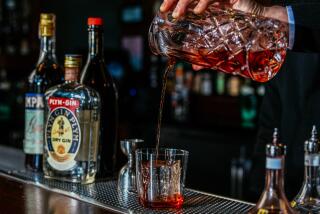Beer-Taster Soaks Up Work’s Benefits
- Share via
ALBANY, N.Y. — His friends call him “Guinness Jim.”
For short, they just call him “Guinness.”
Jim Grace has what a lot of his beer-drinking buddies believe is the dream job. A “draught specialist” for Guinness Import Co., he drives around upstate New York and Vermont sampling the Guinness stout poured in about 675 taverns and restaurants.
“It’s sort of the mecca of jobs, I suppose,” the 25-year-old Grace said. “My job’s really about consistency. A pint poured here in Albany has to taste the same, look the same as a pint poured in Dublin.
“That’s what my job is all about: I’m in pursuit of the perfect pint.”
Grace is one of about two dozen draught specialists working in the United States for Guinness Import, and the company expects to double that number within the year.
Sales of the company’s dark Irish brew have shot up more than 20% for two years in a row--the equivalent in 1996 of 5.7 million cases of beer--at a time when sales of all beer in the United States rose only about 1%. And the location of the booming markets may be a surprise.
“Generally, people would consider New York, Boston or Chicago as typical Guinness markets,” said Guinness spokesman Howard Pulchin. “But our No. 1 market right now is Atlanta, and right behind that is Austin, Texas. Charlotte has seen great growth, Florida has had great growth.”
Michael Byron, owner of Albany’s popular Irish American restaurant Ginger Man, remembers when he first began serving Guinness draft 25 years ago. Back then, the Guinness salesman had to load the kegs into his own station wagon and drive them up from New York City himself.
Today, even with more than a dozen imported and micro-brewed beers on tap such as Samuel Adams, Warsteiner and Pete’s Wicked, Guinness outranks them all in popularity, Byron said.
“It outsells them all by an Irish mile,” said Byron, who emigrated from Sligo, Ireland, 30 years ago.
Pulchin, the Guinness spokesman, credits the draught specialists with helping make the difference in sales by improving and ensuring the consistency of the beer.
“As the pints have gotten perfect here in the U.S., more and more people are drinking Guinness and sales are increasing,” Pulchin said. “It’s a combination of strong marketing and consumer trends, but it’s also word-of-mouth. People who love Guinness love to share a Guinness with someone who’s never had one.”
Grace buys quite a few drinks for others while making his rounds, but since he can usually tell with a glance and sip what, if anything, is wrong with the beer, he may actually drink less than a pint during a working day.
Grace, who was born in Ireland and moved to Long Island when he was 7, has been on the job for a little more than a year. A former sales representative with a Manhattan beer distributor, he lucked into the Guinness job through a family friend who works for Guinness Import Co. in Stamford. Conn., a unit of Guinness PLC of Britain.
On a recent Friday afternoon, Grace was crouched in the cellar of the Ginger Man checking the mix of nitrogen and carbon dioxide pushing the beer through the lines. Letting free a hiss of gas, he showed off the spring-loaded design of a tap made specially for Guinness kegs.
A pint of Guinness could be ruined--and a potential Guinness devotee lost--if soap was left on the glass, if the beer lines weren’t cleaned of built-up yeast, or if the beer wasn’t poured with the trademark creamy head.
“How it looks is really important. That’s how you get other people to drink Guinness. It looks appealing,” Grace said.
He filled a 20-ounce tulip glass, the most appropriate glass from which to drink Guinness, about two-thirds full, then let it settle for a couple of minutes before topping it off with the dense head. Customers at the bar swiveled to watch.
“They say you drink Guinness with your eyes long before you ever drink it with your lips,” Grace said. “It’s true.”
Bartender John Drury, pausing as he washed glasses, offered his opinion: “Pouring Guinness is my second-most favorite part about it. Drinking it is my most favorite.”
But there are those who like neither the taste nor the appearance. They liken the color to mud because it looks black in a pint glass, although it’s actually a deep red.
There are other misconceptions about the drink that Guinness has been brewing in Dublin for 230 years.
For one thing, despite its creaminess, draft Guinness is only 4% alcohol. “Ounce-for-ounce, it’s got fewer calories and less alcohol than Michelob Light,” Pulchin said.
And Guinness shouldn’t be served at room temperature--but rather chilled to between 39 and 45 degrees.
Grace first tasted Guinness when his grandfather bought him a pint in a pub in Ireland. Since then, he’s loved the stuff and admits that even when he doesn’t ask for a Guinness, he’ll ask for a Harp Lager--also brewed by Guinness Import, along with Red Stripe, Bass Ale, Harp Lager, Pilsner Urquell and Woodpecker Cider, “to keep it in the family.”
But it’s a long drive from Albany to Syracuse, and although it’s a great job, it’s still work. Grace sighs, and asks the bartender for a diet soda.
More to Read
Sign up for The Wild
We’ll help you find the best places to hike, bike and run, as well as the perfect silent spots for meditation and yoga.
You may occasionally receive promotional content from the Los Angeles Times.






